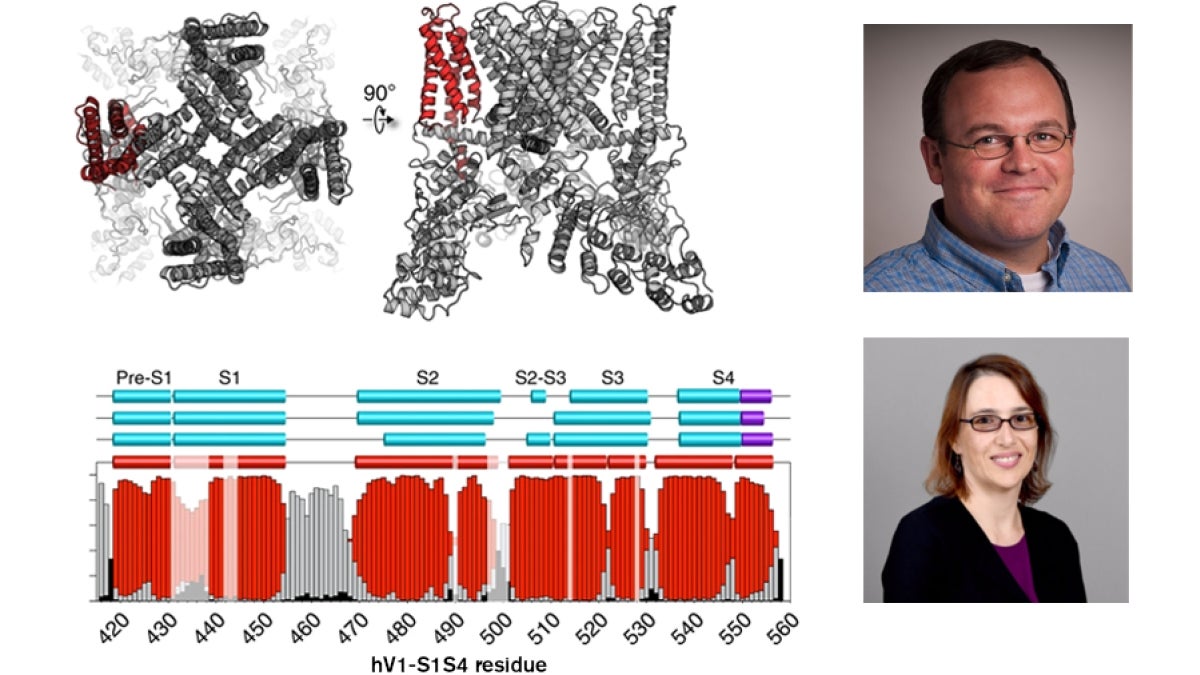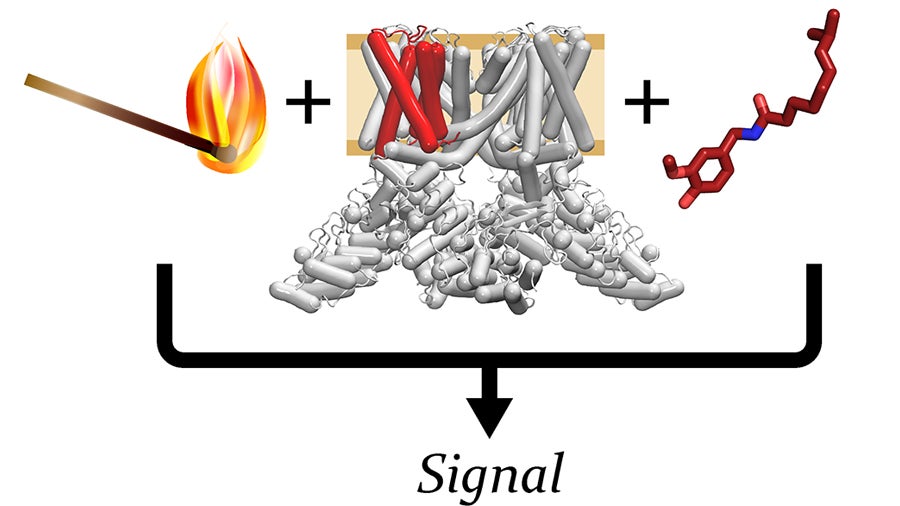ASU research on protein responsible for detection, regulation of body temp part of collection marking Nobel Prize

Top right: Wade Van Horn, associate professor in the School of Molecular Sciences. Bottom right: Marcia Levitus, professor in the School of Molecular Sciences who is also part of the Biodesign Center for Single Molecule Biophysics.
The 2021 Nobel Prize in Physiology or Medicine was awarded on Oct. 3 to David Julius and Ardem Patapoutian "for their discoveries of receptors for temperature and touch." To celebrate, the journal Nature Portfolio presented a collection including further exciting research focused on different aspects of TRP and PIEZO channels, proteins that sense these ubiquitous stimuli.
Included in the collection is a paper published by scientists from Arizona State University's School of Molecular Sciences and the Biodesign Institute in Nature Communications that helps clarify the contributions to an ion channel’s temperature-dependent activation. This in turn should aid in the development of new types of nonaddictive pain therapies.
The ability to sense and respond to temperature is fundamental in biology. Ion channels are formed by membrane proteins that allow ions to pass through the otherwise impermeable lipid cell membrane, where they are used as a communication network.
“TRPV1 is an ion channel that is widely expressed in various tissues and plays a variety of roles in biology,” said Associate Professor Wade Van Horn, senior author of the current research. “It is best known for its role as the primary hot sensor in humans; it is the main way that we sense heat in our environment.”
Although important contributions have been made in the investigation of TRPV1 thermosensing, its mechanism has remained elusive.
TRPV1 is also a common taste and pain sensor — think spicy foods and pepper spray. Beyond these roles, it has been implicated in longevity, inflammation, obesity and cancer. For decades it has been a target in the search for new types of nonaddictive pain medication.
“However, to date, a common feature is that while TRPV1 targeting compounds can relieve pain, they also cause off-target effects, especially causing changes in body temperature, which has limited their utility," Van Horn said. "These off-target effects happen because TRPV1 is activated by many distinct stimuli, including ligands (i.e., capsaicin, the main ingredient in pepper spray), heat and protons (acidic pH).”

Heat activates the TRPV1 channel, which is in the middle. In red is the domain the authors show to be central to heat activation; the molecule on the right is capsaicin. It is the cognate agonist for TRPV1, and it also is the active ingredient in spicy food and pepper/bear spray. In the end, TRPV1 integrates these stimuli, which sends the signals to the brain for interpretation (i.e., TRPV1 is the receptor that initiates signal transduction). Image courtesy of Wade Van Horn
Also particularly limiting is the uncertainty about the mechanisms that underlie temperature-sensing and how the different activation mechanisms are linked together.
This study used a variety of techniques, from cellular to atomic in nature, to investigate the domain of TRPV1 that is key to its ligand activation.
The techniques included nuclear magnetic resonance spectroscopy experiments — like an MRI — aided by Brian Cherry, associate research professional in the Magnetic Resonance Research Center, and intrinsic fluorescence carried out in School of Molecular Sciences Professor Marcia Levitus’ lab. Levitus is also part of the Biodesign Center for Single Molecule Biophysics. Other techniques included far-ultraviolet circular dichroism and temperature-dependent electrophysiology.
Van Horn explains that this work identifies for the first time, both functionally and thermodynamically, that a particular region of TRPV1 is crucial to heat activation. The team proposes, and provides experimental validation for, the heat activation mechanism and details a number of structural changes that happen as the temperature is changed.
This study provides a framework that the team anticipates will be foundational for future studies to further refine how we sense high temperatures and, importantly, how we can distinguish and target specific activation mechanisms that should promote the development of new types of nonaddictive pain therapies.
All the interdisciplinary studies were completed at ASU. The team also included Minjoo Kim, Nicholas Sisco and Jacob Hilton, who are currently postdoctoral researchers at Columbia University, Barrow Neurological Institute and the National Institutes of Health, respectively. Camila Montano and Van Horn are also part of the Biodesign Institute Virginia G. Piper Center for Personalized Diagnostics, and Manuel (Mac) Castro is currently a doctoral student at Vanderbilt University.
More Science and technology

Will this antibiotic work? ASU scientists develop rapid bacterial tests
Bacteria multiply at an astonishing rate, sometimes doubling in number in under four minutes. Imagine a doctor faced with a…

ASU researcher part of team discovering ways to fight drug-resistant bacteria
A new study published in the Science Advances journal featuring Arizona State University researchers has found…

ASU student researchers get early, hands-on experience in engineering research
Using computer science to aid endangered species reintroduction, enhance software engineering education and improve semiconductor…